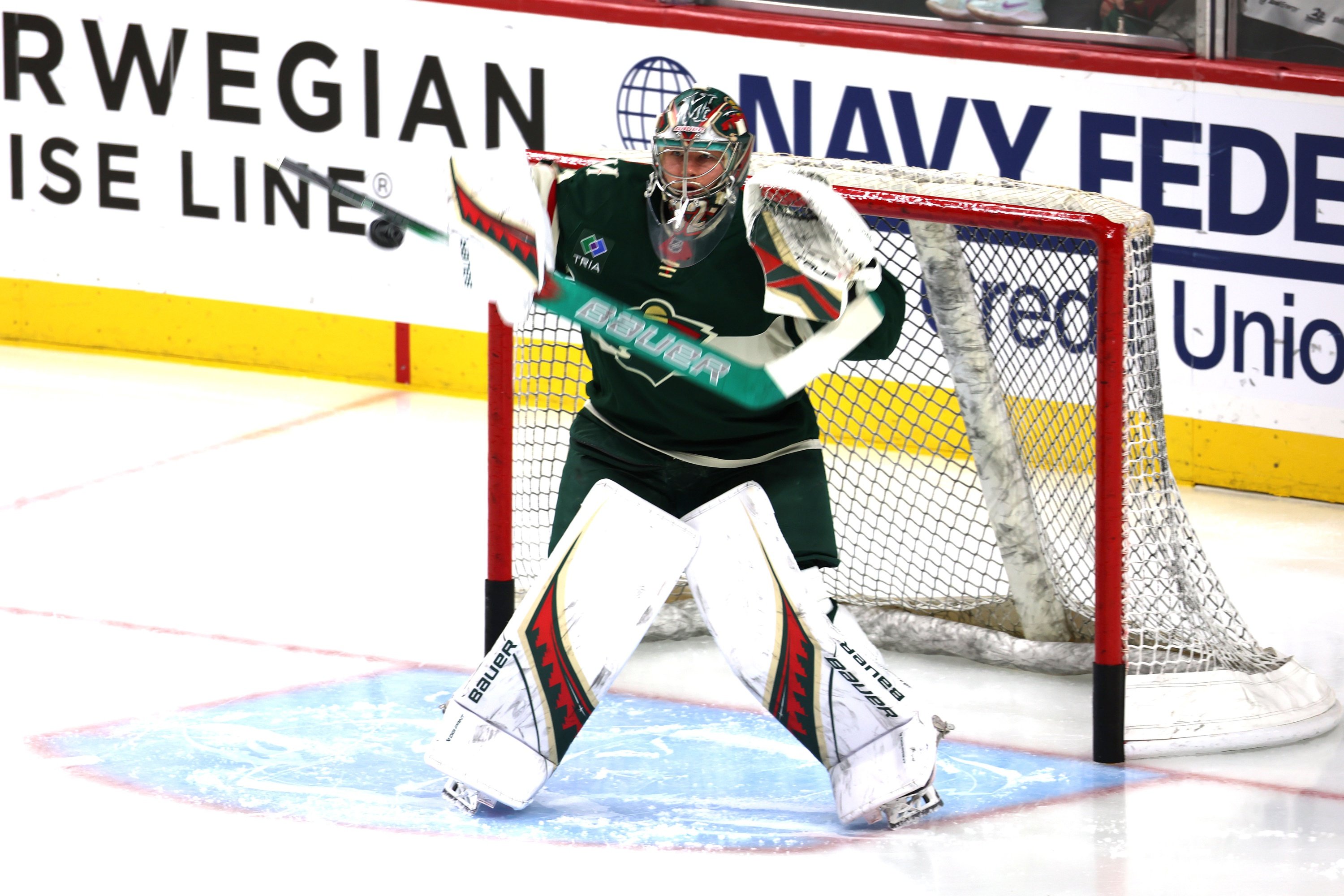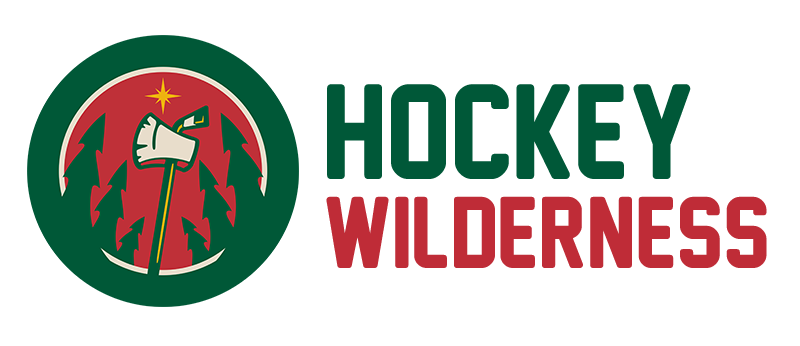
After taking care of Kirill Kaprizov to the tune of eight years and $136 million, the Minnesota Wild decided they weren't quite done with their offseason checklist. Instead of resting on their laurels, they worked quickly to lock down their starting goalie, Filip Gustavsson, with a five-year, $34 million deal.
It's perhaps an acknowledgement that if their superstar scores 50 or even 60 goals, it just takes a little instability in net to thwart a team. Look at the 2023-34 New Jersey Devils. They had 112 points the previous season, but their revolving door of Vitek Vanecek, Nico Daws, Akira Schmid, Jake Allen, and Kaapo Kähkönen kept them in seventh place in their division. It didn't matter that they had Jack Hughes, Nico Hischier, and Jesper Bratt as part of a loaded roster.
Looking at the Wild's steadfast defense, it's fair to say that Gustavsson's .914 save percentage -- sixth in the NHL last year -- isn't entirely reflective of his talent level. Still, he proved last year that he's capable of being a workhorse, starting-caliber goalie. Gustavsson started 58 games, turning in 40 "Quality Starts," which turned out to be the fifth-highest percentage in the league. That's a level of reliability the Wild simply couldn't walk from.
Especially when you look at the alternatives. Minnesota drafted Jesper Wallstedt in 2021 to be the team's "Goalie of the Future." Turns out, the future isn't ready yet. The Wild were hoping to get Wallstedt games last season, but a combination of salary cap issues and his AHL struggles meant he only drew in for two starts. With Gustavsson set to become a free agent next summer, the Wild didn't have time to properly evaluate Wallstedt's readiness to take over starting next year.
Normally, Wallstedt would be out of time. We've seen two of his highly-touted goalie prospect contemporaries -- Spencer Knight (2020 Draft) and Yaroslav Askarov (2021) -- get squeezed out of their team's future after their teams committed long-term to another goalie. Three days after the Florida Panthers drafted Knight, they signed Sergei Bobrovsky to eight years and $80 million. Askarov asked for a trade from the Nashville Predators after they locked in Juuse Saros to an eight-year extension.
That may still be Wallstedt's fate. After all, the Panthers weren't forced to move on from Knight; they traded him as a major piece of the Seth Jones trade, helping them win a Stanley Cup last year. The Wild could choose to leverage Wallstedt in a similar fashion. However, the beauty of Gustavsson's extension is that Minnesota secured long-term stability in net while retaining options.
Minnesota can simply have Gustavsson take the reins as the starting goaltender for the foreseeable future, and that's not a bad spot to be in. His career save percentage is .913, putting him even with former Wild players Marc-Andre Fleury and Devan Dubnyk through age 26. Once you adjust to the league average save percentage, as Stathead does with their Goals Allowed Percentage- which sets 100 as league average, Gustavsson fares very well.
GA%- through Age-26, Since 2007-08, minimum 90 starts:
- Igor Shesterkin, 78
- Tuukka Rask, 82
- Juuse Saros, 90
- Jaroslav Halák, 91
- Andrei Vasilevskiy, 91
- FILIP GUSTAVSSON, 91
- Braden Holtby, 92
- Jake Oettinger, 92
- Logan Thompson, 93
- Josh Gibson, 94
Even if you suspect his numbers make him look better than he is, he still is an above-average workhorse. The hockey equivalent of an innings-eating pitcher, if you will. Again, looking at the Devils, this time in 2024-25, that type of "innings-eater" was all they needed to get back into the playoff picture.
The five-year term also comes in handy here. Gustavsson's extension will only take him through his age-32 season. Wild fans saw Devan Dubnyk start to fall off a cliff in his age-33 year, and Niklas Bäckström become unusable at age-34. If Gustavsson winds up taking a similar path on the aging curve, Minnesota should be getting out of this deal just in time.
The term also means they don't have to hard-commit to Gustavsson at the expense of Wallstedt. Wallstedt's contract takes him through the summer of 2027, at which point he'll become a Restricted Free Agent. However, once that ends, the Wild still have him under team control through 2030, another three years after that. By comparison, that's only one year of team control less than they have with Gustavsson.
When Wallstedt's contract is up, he'll most likely be in position to get a bridge deal. Barring injury, Gustavsson is a safe bet to take the majority of starts this season, and unless Wallstedt is markedly better, it's hard to see him forcing anything more than a 50/50 split in 2026-27. If the Wild can lock Wallstedt into an affordable rate through 2029, they're in a great spot beyond that.
By 2029, Minnesota should have more than enough information on whether they want to have Wallstedt be The Guy going forward. If they do, they have two big advantages to avoid having Gustavsson squeeze Wallstedt out prematurely. The first is Gustavsson's trade clauses. He'll have a No-Move Clause through the summer of 2028, which turns into a 15-team no-trade clause afterward. That's a fair bit of flexibility to move on if the Wild feel the need to.
The other advantage is the sheer affordability of Gustavsson's deal. That doesn't appear to be the case right away, but with the cap rising, we have to recalibrate what "$6.8 million" means. Gustavsson is set to be the 10th-highest-paid goalie next season, and his contract will only represent 6.5% of the salary cap -- roughly the equivalent of $5.8 million last year. If there's a time when Minnesota has to pay Wallstedt like a 1B goalie, they can do that without spending too much of their resources on the goalie position.
The most important thing that the Wild could do was guarantee themselves a decent floor in net for the long term, and Gustavsson's contract does exactly that. That makes the extension worth it by itself. But the real value add for Minnesota was that they were able to do that without sacrificing their flexibility at the goalie position. They can either commit to Gustavsson long-term or establish a succession plan for Wallstedt, and they should be able to make that decision on their own terms. As important as the AAV and term are to evaluating contracts, it's hidden benefits like this that can turn a deal into a home run.
Think you could write a story like this? Hockey Wilderness wants you to develop your voice, find an audience, and we'll pay you to do it. Just fill out this form.
-
 5
5
-
 2
2









Recommended Comments
Join the conversation
You can post now and register later. If you have an account, sign in now to post with your account.
Note: Your post will require moderator approval before it will be visible.